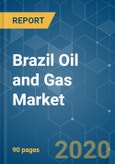The brazil oil and gas market is expected to grow at a CAGR of more than 3.5% in the forecast period of 2020-2025. Factors such as the reduction in the cost of the offshore drilling rigs, increasing offshore activities, and expansion in the country's refining sector are likely to drive brazil oil and gas market in the forecast period. However, the declining oil and gas production from its mature fields, highly volatile oil and gas prices, and delay of projects are expected to have a negative impact on the brazil’s oil and gas market during the forecast period.
Key Market Trends
Upstream Sector as a Significant Market
Increasing Deep-Water Activities and Pipeline Infrastructure to Drive the Market
Competitive Landscape
The Brazil oil and gas market is consolidated. Some of the key players in the market include Petroleo Brasileiro S.A., Exxon Mobil Corporation, B.P. plc, Royal Dutch Shell Plc, and Total S.A. and others.
Reasons to Purchase this report:
This product will be delivered within 2 business days.
- The upstream sector accounted for a significant market share in 2018, and it is likely to dominate the market during the forecast period.
- Brazil is estimated to increase its oil production by 70% by 2035. With favorable conditions in the oil and gas sector, it can attract upstream companies for exploration and development activities in the region. Moreover, Petrobras' new Strategic Plan 2040, which aims to increase investment and prioritizing its activities mainly in deep water is expected to create opportunity for the market to grow in the near future.
- Increasing deep-water activities and pipeline infrastructure are likely to drive the brazil oil and gas upstream market in the forecast period.
Key Market Trends
Upstream Sector as a Significant Market
- As of 2018, Brazil was the 10th largest producer of oil and gas in the world, the largest producer in South America and the 7th largest oil products consumer in the world. Almost 80-90% of oil and gas produced in Brazil are from the offshore.
- Brazil’s deep-water projects are dominating the oil and gas upstream sector and are likely to dominate the market in the forecast period. For instance, in 2018 nearly 56% of the oil and gas production comes from deep-water, and around 37% comes from shallow water.
- During 2019, Petróleo Brasileiro S.A. (Petrobras) has awarded MODEC to install the fifth Floating, Production, and Storage Offshore (FPSO) Unit in Buzios field for its development. The FPSO is estimated to process 150,000 barrels of crude oil per day, 212 million standard cubic feet of gas per day, 240,000 barrels of water injection per day and will have a minimum storage capacity of 1,400,000 barrels of crude oil. The first oil production by the FPSO is planned for 2022.
- Libra oil field in Santos Basin in Brazil is an ultra-deep-water basin, and is the largest oil field in Brazil, which is under development phase, and is expected to come online in 2021. This is likely to have a positive impact on the brazil oil and gas upstream market in the forecast period.
Increasing Deep-Water Activities and Pipeline Infrastructure to Drive the Market
- Deep-Water projects in the past decade have dominated the upstream brazil oil and gas sector, and with growing development in the pre-salt region of the country, it is expected to drive the market during the forecast period.
- During 2018, Brazil has installed nearly 29 offshore rigs and 20 onshore rigs, with rising activities in the offshore region especially in Campos and Santos basin, the numbers of rigs and FPSO installation are expected to increase.
- Brazil's pipeline infrastructure holds a significant market share in the countries downstream sector. As of 2019, the country has nearly 3100 kilometers of the under-construction gas pipeline, which is expected to expand the pipeline infrastructure market during the forecasting period.
- There are nearly three major pipeline projects in the country, which include both capacity expansion pipeline and newly construct pipelines. Capacity expansion pipeline includes the Bolivia-Brazil pipeline (GASBOL), which is expected to increase its capacity to 3.6 million cubic meters by 2022. The new construction of the gas pipeline includes the gas pipeline between Argentina and Brazil, and Sao Carlos, Sao Paulo, and Brasilia.
- During 2018, Brazil has 84 developed fields that are majorly on onshore. The development of the fields is expected to install new oil and gas pipelines and thus is expected to boost the overall oil and gas market of the country in the near future.
Competitive Landscape
The Brazil oil and gas market is consolidated. Some of the key players in the market include Petroleo Brasileiro S.A., Exxon Mobil Corporation, B.P. plc, Royal Dutch Shell Plc, and Total S.A. and others.
Reasons to Purchase this report:
- The market estimate (ME) sheet in Excel format
- 3 months of analyst support
This product will be delivered within 2 business days.
Table of Contents
1 INTRODUCTION
4 MARKET OVERVIEW
5 MARKET SEGMENTATION
6 COMPETITIVE LANDSCAPE
Companies Mentioned (Partial List)
A selection of companies mentioned in this report includes, but is not limited to:
- Petroleo Brasileiro S.A. (Petrobras)
- Exxon Mobil Corporation
- BP Plc.
- Royal Dutch Shell Plc.
- Total S.A.
- Equinor ASA
- Enauta Participacoes SA
- Murphy Oil Corporation
- Chevron Corporation
- Gas TransBoliviano SA
Methodology

LOADING...








